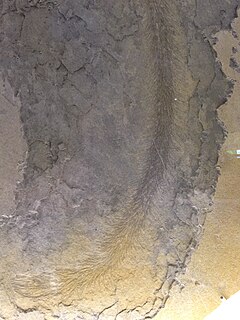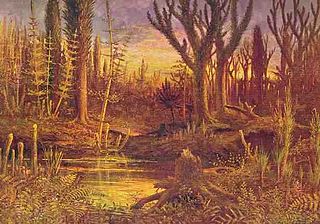The Carboniferous is a geologic period and system of the Paleozoic that spans 60 million years from the end of the Devonian Period 358.9 million years ago (Mya), to the beginning of the Permian Period, 298.9 million years ago. The name Carboniferous means "coal-bearing", from the Latin carbō ("coal") and ferō, and refers to the many coal beds formed globally during that time.

The Devonian is a geologic period and system of the Paleozoic, spanning 60.3 million years from the end of the Silurian, 419.2 million years ago (Mya), to the beginning of the Carboniferous, 358.9 Mya. It is named after Devon, England, where rocks from this period were first studied.

The lycophytes, when broadly circumscribed, are a vascular plant (tracheophyte) subgroup of the kingdom Plantae. They are sometimes placed in a division Lycopodiophyta or Lycophyta or in a subdivision Lycopodiophytina. They are one of the oldest lineages of extant (living) vascular plants; the group contains extinct plants that have been dated from the Silurian. Lycophytes were some of the dominating plant species of the Carboniferous period, and included tree-like species, although extant lycophytes are relatively small plants.

Petrified wood, also known as petrified tree, is the name given to a special type of fossilized wood, the fossilized remains of terrestrial vegetation. Petrifaction is the result of a tree or tree-like plants having been replaced by stone via a mineralization process that often includes permineralization and replacement. The organic materials making up cell walls have been replicated with minerals. In some instances, the original structure of the stem tissue may be partially retained. Unlike other plant fossils, which are typically impressions or compressions, petrified wood is a three-dimensional representation of the original organic material.

The Late Devonian extinction consisted of several extinction events in the Late Devonian Epoch, which collectively represent one of the five largest mass extinction events in the history of life on Earth. The term primarily refers to a major extinction, the Kellwasser event, which occurred around 372 million years ago, at the boundary between the Frasnian stage and the Famennian stage, the last stage in the Devonian Period. Overall, 19% of all families and 50% of all genera became extinct. A second mass extinction, the Hangenberg event, occurred 359 million years ago, bringing an end to the Famennian and Devonian, as the world transitioned into the Carboniferous Period.

The zosterophylls are a group of extinct land plants that first appeared in the Silurian period. The taxon was first established by Banks in 1968 as the subdivision Zosterophyllophytina; they have since also been treated as the division Zosterophyllophyta or Zosterophyta and the class or plesion Zosterophyllopsida or Zosteropsida. They were among the first vascular plants in the fossil record, and had a world-wide distribution. They were probably stem-group lycophytes, forming a sister group to the ancestors of the living lycophytes. By the late Silurian a diverse assemblage of species existed, examples of which have been found fossilised in what is now Bathurst Island in Arctic Canada.

Baragwanathia is a genus of extinct lycopsid plants of Late Silurian to Early Devonian age, fossils of which have been found in Australia, Canada, China and Czechia. The name derives from William Baragwanath who discovered the first specimens of the type species, Baragwanathia longifolia, at Thomson River.

Arthropleura is a genus of extinct millipede arthropods that lived in what is now North America and Europe around 345 to 290 million years ago, from the Viséan stage of the lower Carboniferous Period to the Sakmarian stage of the lower Permian Period. The species of the genus are the largest known land invertebrates of all time, and would have had few, if any, predators.

Drepanophycales is an order of extinct lycopsid plants of Late Silurian to Late Devonian age, found in North America, China, Russia, Europe, and Australia. Sometimes known as the Asteroxylales or Baragwanathiales.

Megarachne is a genus of eurypterid, an extinct group of aquatic arthropods. Fossils of Megarachne have been discovered in deposits of Late Carboniferous age, from the Gzhelian stage, in San Luis, Argentina. The fossils of the single and type species M. servinei have been recovered from deposits that had once been a freshwater environment. The generic name, composed of the Ancient Greek μέγας (megas) meaning "great" and Ancient Greek ἀράχνη (arachne) meaning "spider", translates to "great spider", because the fossil was misidentified as a large prehistoric spider.

The cladoxylopsids are an extinct group of plants related to ferns and sphenopsids.

Quasipetalichthys haikouensis is the type and only known species of the extinct petalichthid placoderm, Quasipetalichthys. Fossil remains of Quasipetalichthys have been found in the Middle Devonian, Givetian faunal stage of China.
Huia is a genus of extinct vascular plants of the Early Devonian. The genus was first described in 1985 based on fossil specimens from the Posongchong Formation, Wenshan district, Yunnan, China.

Adoketophyton is a genus of extinct vascular plants of the Early Devonian. The plant was first described in 1977 based on fossil specimens from the Posongchong Formation, Wenshan district, Yunnan, China. These were originally named Zosterophyllum subverticillatum; later the species was transferred to a new genus as Adoketophyton subverticillatum. One cladistic analysis suggested that it is a lycophyte, related to the zosterophylls. Other researchers regard its placement within the vascular plants as uncertain.
Distichophytum is a genus of extinct vascular plants of the Late Silurian (Ludfordian) to Early Devonian (Emsian), around 426 to 393 million years ago. The genus has a tangled taxonomic history, also being known as Bucheria and Rebuchia.
Konioria was a genus of early land plant with branching axes. Known fossils are of Early Devonian age.
Barinophyton was a genus of early land plant with branching axes. It is placed in a group of early vascular plants (tracheophytes), the barinophytes, a group that has been given various ranks and scientific names. Known fossils are of Devonian to Carboniferous age.
Protobarinophyton was a genus of Silu-Devonian land plant with branching axes. It is placed in a group of early vascular plants (tracheophytes), the barinophytes, a group that has been given various ranks and scientific names.

The Protolepidodendrales are an extinct order of lycopsids that flourished from the Devonian to the lower Carboniferous (Mississippian) periods.

The Devonian explosion was a period of rapid plant diversification that occurred 359-419 million years ago during the Devonian. This diversification of terrestrial plant life had vast impacts on the biotic composition of earth's soil, its atmosphere, its oceans, and for all plant and animal life that would follow it. Through fierce competition for light and available space on land, phenotypic diversity of plants increased greatly, comparable in scale and effect to the explosion in diversity of animal life during the Cambrian explosion, especially in vertical plant growth, which allowed for photoautotrophic canopies to develop, and forever altering plant evolutionary floras that followed. This Devonian flora was significantly different in appearance, reproduction, and anatomy to most modern flora. Much of this flora had died out in extinction events including the Devonian mass extinction and the Carboniferous Rain Forest Collapse.













